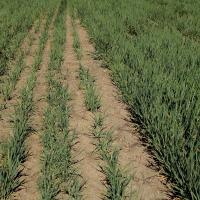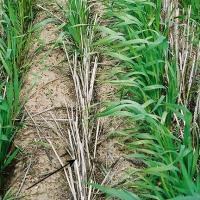If there is a large difference between the numbers of tillers and heads measured in cereals it may indicate that the crop has been placed under some form of stress during this period. This may not be a bad thing as good early growing conditions in lower rainfall areas set too much potential for a dry finish. Or it means that excessive N fertiliser was applied early in the crop development.
How to measure tiller numbers
- Using a ruler or a 50 cm length of rope, place it at random between two rows of crop.
- Count and record the number of tillers along each row on both sides of the ruler. This is the total tiller number per metre row of crop.
- Repeat counts at 10 sites along the monitoring path
- Calculate the average of the 10 counts, and enter this figure into the equation below
To convert tillers/m to tillers/m² = Ave tiller no/metre of row X 100 e.g. 60 tillers/m X 100 = 400 tiller / m²
Row spacing (cm) 15 cm



